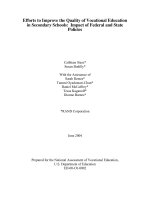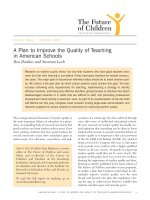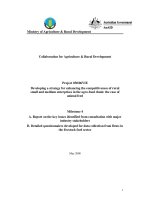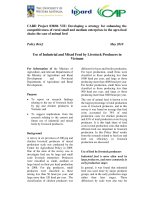Inequality in singapore requirements for enhancing the quality of public debate
Bạn đang xem bản rút gọn của tài liệu. Xem và tải ngay bản đầy đủ của tài liệu tại đây (122.92 KB, 7 trang )
469C Bukit Timah Road
Oei Tiong Ham Building
Singapore 259772
Tel: (65) 6516 6134 Fax: (65) 6778 1020
W
ebsite: www.lkyspp.nus.edu.s
g
Lee Kuan Yew School of Public Policy
Working Paper Series
Inequality in Singapore: Requirements for Enhancing the Quality of
Public Debate
Mukul G Asher
Professorial Fellow
Lee Kuan Yew School of Public Policy
National University of Singapore
Email:
October 17, 2014
Working Paper No.: LKYSPP 14-33
This paper is prepared for: A panel on Inequality and Social Security Reform,
at the 10th Anniversary conference, LKYSPP, NUS, October 17, 2014
2
ThepublicationofThomasPiketty’s2014book“CapitalintheTwentyFirstCentury”hasbeena
catalyst in bringing the issue of inequality to the forefront of public policy debates in many
countries.Thisis remarkable,giventhebook’sleng th (696pages),intricaciesofhistoricaldata
seriesfrommany sources formingthe statisticalfoundations of thebook’s main propositions;
complexity of theoretical and empirical reasoning employed; and
relatively narrow
geographicalfocus(mainlyUS,U.K.,andwesternEurope).
Mr. Piketty’s data sources, statistical evidence, theoretical reasoning, and policy suggestions
continue to receive searching scrutiny. This is likely to result in better understanding of the
inequalityissuearoundtheworld.
The issues of inequality, social mobility prospects, and of fairness
and adequacy of social
protection arrangementshave re cently been pro minent inpublic policy debates in Singapore,
and this is likely to continue. It may therefore be instructive to examine two implications of
Piketty’sbookforenhancingthequalityofpublicpolicydebateontheseissuesinSingapore.
The first implication con cerns
the exemplary research cu lture and norms exhibited by Mr.
Piketty (and many but not all who have been critiquing his work). Thus Mr. Piketty bases his
analysisofinequalityonempiricalevidence,muchofithistoricalandderivedfromadiversityof
sources. He is open to refinement of his
data and analysis. His admirable inclination to be
transparent about the data, and willingness to advance public debate by encouraging other
researchers to examine and duplicate his results by making it available to them without cost
and pre‐conditions, sets the right example for researchers, academics, think tanks, and
government agencies.
Asymmetric information between those given responsibilities to collect
dataandtheusersisoneofthesignificantsourcesofpoorpublicpoliciesaroundtheworld.
There is considerable scope in Singapore for progressing towards the research culture and
normsexhibitedbyMr.Piketty.Thereisconsiderablemeritinconsideringa
shiftbyconcerned
3
stakeholdersinSingaporefromregardingsocio‐economicinformationasastrategicoratactical
resource to regarding it as a public good to be shared widely and without unduly restrictive
conditions. For enhancing quality of social science research, including on inequality and social
protection issues, routine publication of suitably modified raw
data, and methodology used
should become a no rm in Singapore. Without such progress, Singapore will be severely
constrained in using wider expertise to improve its policies and their outcomes; and in
enhancingcredibilityandtrustwhichhavebecomevitalasdifficultpublicpolicytrade‐offsare
needed.
The second implication
arisesfrom the keyrelationship of rate of return on capital exceeding
rate of economic growth, and important indicators used by Mr. Piketty. A key distinction is
madeinthebookbetweensharesofnationalincomeaccruingtolaborandtocapitalasfactors
of production. In analyzing household income,
key indicator used is the share of income
accruing to top ten percent of the households. Household income from all sources and all
factorsofproductionisincluded.
InSingapore,theestimatesofrateofreturntocapitalarenotavailable,thusitiscurrentlynot
feasible to ascertainwhether the
return oncapital e xceeds rate of economic growth.Publicly
available data on share of labour and capital and on household income indicators have a
restrictivescopethatmeritsreconsideration.
As an illustration, while data on share of national income accruing to labor and to capital is
published (with capital share
at around 55 percent exceeding labor share at ar ound 45
percent), it would be useful to provide a longer and consistent time series on the respective
shares; and feasible disaggregation of each share. An expansion of the factor share trends to
include labor and capital income accruing abroad, but not included
currently, could also be
usefulasSingaporehaslargenetexternalassets.
4
Thehouseholddistributionofincomeincludesonlyresident(citizenspluspermanentresidents)
employed household, and their income from work, thus excluding unemployed and income
fromcapital.Thedatafortop1percentofhouseholdsarenotprovided.Eventhen,theratioof
income of the households in the highest decile to
those in the lowest decile has increased
sharplyfrom11.5in2000to16.8in2013,suggestingrisinginequalityevenforlaborincome,an
issuewhichmeritsconsideredpolicyresponses.Theneedforimprovingtheconsistencyofthe
governmentdataisillustratedbythefactthatanotherofficialsource,while
notprovidingtime
series,reportsthetop10percentofhouseholdsreceiving24.1timesthelabourincomeofthe
bottom 10 percent in 2013. The difference between the two numbers is too large and needs
explanation.
As the share of the retired aged increases and they withdraw from the labour
force, this
indicator will be increasinglyless informative and relevantfor policypurpose as an increasing
proportion of the population will be re ceiving income outside of labor work. Disruptive
technologiesaffectingjobsandrequiringdeeperandmorefrequentrestructuringalsowillhave
similarimpact.
The above trends raise legitimate concerns
about Singapore’s growth strategy requiring
persistentlyandsignificantlyhighercapitalshares.Excessivelylargeincomeinequalitymakesit
difficult to rebalance the economy towards greater reliance on domestic consumption.The
forces of convergence which over time mitigate income inequalities (Emily Eakin, April 17,
2014, “Capital Man”, The Chronicle of Higher Education: The
Chronicle Review), primarily
throughwidereducationandcareeropportunities,havereachedapointwheretheirimpactis
weakening globally as well as in Singapore.Butforces of divergence, particularly high capital
incomeshares, wealthinequalities(thereis astrongcaseformeasuringand regularlymaking
available data on wealth inequalities
in Singapore),public policies which intentionally or
unintentionallyrewardcertai noccupationsdisproportionately(financesectorrecently,insome
countriespublic serviceandaccess itprovides to income andwealthopportunities), tendency
toward “winner‐take all” rewards in the labour market; and wide divergence in social
5
protectionarrangementsfordifferentincomeandsometimesgeographicalgroups,particularly
as share of elderly population increases, appear to be getting stronger globally as well as in
Singapore.Thissuggeststhatattributingrisingincomeinequalitiesprimarilytogeneralforcesof
globalizationisinappropriate.
The estimates for Gini coefficient, a widely used
indicator of household income inequality,
include only wage income in Singapore, excluding capital income which is usually much more
unequally distributed. The unadjusted Gini coefficient is officially estimated at 0.47 (the
coefficient ranges from 0 to 1, with higher value implying greater inequality), and just under
0.46 after transfers and taxes.
If capital income were included, the coefficient is likely to be
significantlyhigher.Addressingthisgapin publicdebates willsignificantlyenhancethe quality
ofpolicydiscourseinSingapore.
Research conducted by the European Central Bank and by the World Bank suggests that
incomesoftop1percentofthe
incomegroupintheU.S(andmostprobablyinothercountries)
is undercounted, implying that the current methods understate income inequality ( Jeanna
Smialek“UndervaluedRichesofTop1%PointtoGreaterGlobalInequality”Bloomberg,August
7, 2014). Singapore could also consider disaggregating income levels of super‐high
income
individuals further by publishing shares of national income accruing totop 5 % and top 1% of
theindividualsandhouseholds.
Theabsenceofsocialinsurancemethodsinthepensionandhealthcarefinancingmechanism,
andusingabsoluteratherrelativepovertyasguideforpublicpoliciesimpactsonfairnessand
adequacy of the social protection arrang ements in Singapore. Less robust provision for social
protection for lower half as compared to upper half, particularly top 10 percent, of the
population is one of the contributors to inequality globally. Singapore's relatively low labor
sharesuggeststhatthisfactorwouldbeevenmore
significantcontributortoinequalitythanis
thecaseincountrieswithrelativelyhighlaborshareinnationalincome.
6
A significant contributor to rising longevity is the higher life expectancy experienced by
successivecohortsinmiddleandlaterages.Thissuggeststhatdebatesoninequalityandsocial
protectionsystemsinSingaporeneedstotakesuccessivecohorts,especiallymorerecentones,
into account, rather taking aggregate mean or other indicators. An
explanation by the
policymakers concerning how this factor has been taken into account, including assumptions
made,andsimulationsconducted,wouldbehelpfulinenhancingpublicpolicydiscussions.
Theauthoritiesarestronglyurgedtoconsiderpublishingactualcashbalancesofallmembersof
the Central ProvidentFund (CPF),suitably classified such
as by age, andsex; routinely publish
actual nominal and real returns on CPF balances (which were SGD253 billion as at end 2013,
equivalent of 68 percent of GDP) earned by Singapore as a country, as well as the return
credited in the individual accounts of members; and publishing household consumption,
and
income‐expenditure surveys on a regular andand comprehensive basis. These would be
consistentwiththespiritof Mr.Picketty’sbookandthecurrentglobaldebateoninequality.
In Public Policy debates on inequality and on special security reforms, the policymakers have
the tendency to say “trust us”. The
stakeholders increasingly lean towards “trust but verify”
mind‐set. Unless policymakers enable stakeholders to credibly verify official data and
information,andunless there is consistencybetweenwords and deeds,virtuous circle cannot
besustainedinthefuture.
Establishment of such a virtuous circle is essential as research suggests that the role
of
perceptionsisalsoimportantintheinequalitydebateisconsistentwiththeaboveargument.As
an example, people in Germany perceive inequality to be worse than it actually is, while the
reverse is the case for the U.S (Stefan Wagstyl, “Europe Pessimistic on income equality, but
Americansstillcling
ontothedream”,TheFinancialTimes,August18,2014).
Let me end with a summary of some specific measures meriting consideration of the
policymakerswhichcouldassistinbetteraddressingtheinequalityissueinSingapore:
7
i. Social(notcommercial)insuranceprinciplesforCPFlife,withbenefitslinkedtorelative
income, and the difference between receipts and benefits filled through budgetary
resources.
ii. Social insurance principle for Medishield Insurance scheme. In (i) and (ii), this would
meanthatpremiumsorannuitycostswillnotdifferbetweenmen
andwomen,andwill
not be based on age. Future benefits will also be made more certain, and actuarial
calculations,withallassumptions,published.
iii. Introduction of social pensionto allelderly beyond65years of age,but benefitsmade
taxable.
iv. Crediting CPF members with the returns actually obtained
from CPF balances in a
transparentandaccountablemanner,orprovisionofa rationaleastowhythatisnotan
appropriatepolicy.
v. Selectiveincreasesin taxes oncapitalincome (eg:slightlyraisingthecorporateincome
tax;inclusionofcertaininterest,dividend,andcapitalgainsincomeinincometax)
vi.
Broadening the scope and enhancing benefit levels of social welfare programs, linking
themtoameasureofinflation.
vii. Finetuningbusiness locationbasedstrategytonarrowthegapinlaborincomebetween
low and high wage earners; andarrangements to assist workers affected by disruptive
technologiesandotherfactor
requiringdeeperandmorefrequentrestructuring.
viii. Consider addressing the perception that there is a need to broaden the pool or the
groupsfromwhichselectionofpersonswithopportunitiesforupwardmobility,andfor
accesstohighincomesandpower.
Thankyou.









